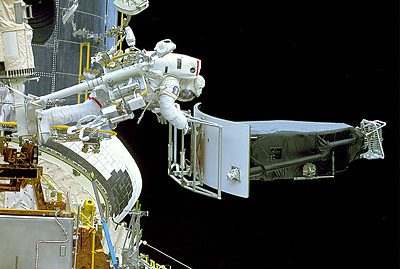The Wide Field and Planetary Camera 2, along with the "contact lens" that corrected the defect in the Hubble Space Telescope's primary mirror will have a new home. Recently returned to Earth after more than 15 years in space, the two instruments will have a new home in the Smithsonian's National Air and Space Museum in Washington. Astronauts on the Hubble servicing mission in May 2009 replaced WFPC-2 with a new and improved version, bringing the well-used camera back to Earth. "This was the camera that saved Hubble," said Ed Weiler, from NASA's Science Mission Directorate. "I have looked forward for a long time to stand in front of this very instrument while on display to the public."
WFPC-2, and the Corrective Optics Space Telescope Axial Replacement, or COSTAR, gave Hubble the ability to take the images that have changed the way we see the Universe by providing the iconic images that now adorn posters, album covers, the Internet, classrooms and science text books worldwide.
The Hubble instruments will be on display in the National Air and Space Museum's Space Hall through mid-December. They then will travel to Southern California to go on temporary display at several venues. In March 2010, the instruments will return to the Smithsonian Air and Space Museum, where they will take up permanent residency.
After Hubble's launch and deployment aboard the shuttle in 1990, scientists realized the telescope's primary mirror had a flaw, known as a spherical aberration. The outer edge of the mirror was ground too flat by a depth of 2.2 microns, roughly equal to one-fiftieth the thickness of a human hair. This tiny flaw resulted in fuzzy images because some of the light from the objects being studied was scattered.
Hubble's first servicing mission provided the telescope with hardware that basically acted as eye glasses. Launched in December 1993 aboard space shuttle Endeavour, the mission added the WFPC-2, about the size of a baby grand piano, and COSTAR, about the size of a telephone booth. The WFPC-2 had the optical fix built in, while the COSTAR provided the optical correction for other Hubble instruments.
The WFPC-2 made more than 135,000 observations of celestial objects from 1993 to 2009. The camera was the longest serving and most prolific instrument aboard Hubble.
"For years the Wide Field and Planetary Camera 2 has been taking pictures of the universe," said John Trauger of NASA's Jet Propulsion Laboratory in Pasadena, Calif. "Today, we are taking pictures of the WFPC-2 and I guess if there was ever a camera that deserves to have its picture taken, this is it."
 Universe Today
Universe Today
